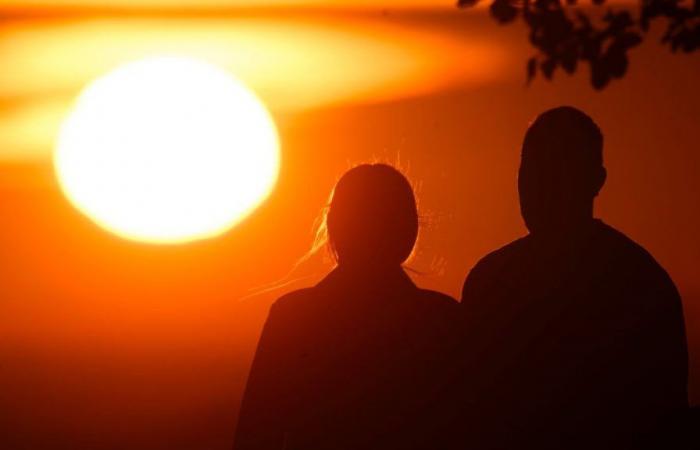NEW YORK — Summer begins this week in the Northern Hemisphere with the summer solstice. The summer solstice marks the longest day and shortest night of the year.
On Friday the first full moon of summer rises. It is known as the strawberry moon because its date coincides with the strawberry harvest.
Many cultures, both ancient and modern, celebrate sunlight with rituals and festivals.
What is the summer solstice?
The term solstice comes from the Latin words “sol” (sun) and “stitium” (still or stopped). It is used to describe the exact moment at which the poles are most tilted towards or away from the sun.
The summer solstice occurs when the sun is directly over the Tropic of Cancer, which is the circle that marks latitude 23.5 degrees north, and that runs through Mexico, the Bahamas, Egypt, Saudi Arabia, India and southern China, according to the Service. National Meteorological. For those who live above the Tropic of Cancer, it is the longest day of the year.
For those who live in the southern hemisphere, this is the shortest day of the year and marks the arrival of winter. The longest day of the year for those south of the equator occurs between December 20 and 22, when the sun is directly over the Tropic of Capricorn. In contrast, the northern hemisphere will mark the winter solstice by experiencing the shortest day of the year.
When is the summer solstice of 2024?
The summer solstice usually falls between June 20 and 22 each year. This year, the solstice occurs on June 20 at 4:51 pm Eastern Time.
What is the strawberry moon?
This year’s summer solstice comes with a surprise: the first full moon of the summer, called the strawberry moon. The moon will not be pink or red: its name comes from several indigenous tribes who noticed that its date coincided with the strawberry harvest.
On Friday night, look southeast for a glimpse of the full moon rising over the horizon.
What are the traditions and rituals of the summer solstice?
The summer solstice has been observed by humans since the Stone Age and was an important holiday for many ancient cultures.
In the past, midsummer traditions included scattering bonfire ashes in the garden for a bountiful harvest, to wearing protective garlands of herbs and flowers to ward off evil spirits, according to History.com.
“The importance of the summer solstice to ancient cultures had many aspects, including calendaring, planting crops and agriculture, moving camps or accommodation sites for nomadic people, and annual cultural ceremonies,” said Aparna Venkatesan, professor associate of the Department of Physics and Astronomy at the University of San Francisco.
The ancient Romans celebrated the arrival of summer with a religious festival in honor of Vesta, goddess of the home, according to History.com. Women entered temples named after the goddess to leave offerings in the hope of receiving good blessings for their families.
In ancient Greece, the summer solstice sometimes marked the new year and became a time to celebrate a festival in honor of Cronus, the god of agriculture. Even slaves were allowed to break social codes and participate in the festivities.
The alignment of ancient archaeological structures such as the Great Pyramids of Cheops and Khafre on the Egyptian Giza Plateau suggests that Ancient Egypt also observed the summer solstice. This is because if you are standing directly in front of the Sphinx, the sun sets precisely between the two pyramids on the summer solstice.
Many Native American tribes performed solstice rituals. According to History.com, the Sioux participated in a “ceremonial sun dance around a tree wearing symbolic colors.” Researchers believe that Wyoming’s Bighorn Medicine Wheel, an arrangement of stones that aligns with the rising sun on the summer solstice, was the site of the tribe’s annual dance. The remaining tribes still participate in solstice rituals, according to History.com.
What does Stonehenge have to do with the summer solstice?
Stonehenge, the 5,000-year-old ring of standing stones in southwestern England, aligns with the direction of sunrise on the summer solstice. And although History.com notes that there is little archaeological evidence to suggest that the site was used for prehistoric rituals, thousands of visitors, many of them in colorful costumes, gather annually around the monument to watch the sunrise.
How can you celebrate the summer solstice?
People around the world celebrate the summer solstice with parties, bonfires, picnics, and traditional songs and dances.
In Sweden, the summer solstice is marked with summer celebrations, as citizens enjoy the end of a long winter with a variety of pagan traditions, according to the Swedish Institute. People start the day by picking flowers and making wreaths to hang on maypoles, which are then used for traditional circle dances. According to local superstition, unmarried girls who place flowers under their pillow before going to bed will dream of their future husbands. Modern Swedes believe it is a magical time for love; Many weddings and baptisms are celebrated around the solstice.
Followers of modern Wicca, a nature-based pagan religion based on pre-Christian traditions, celebrate the Sun God on the longest day of the year with fruitful picnics at flower-decked altars. According to Liza Chamberlain, author of “Wicca for Beginners: A Guide to Wiccan Beliefs, Rituals, Magic, and Witchcraft,” the midsummer Wiccan Sabbat celebration, or “Litha,” marks the “pinnacle of the Sun’s power to fuel the rising season.”
Every year, thousands of yogis from around the world flock to Times Square in New York City to celebrate the summer solstice with free yoga classes. The annual yoga festival, “Solstice in Times Square: Mind Over Madness Yoga,” launched in 2003 and was designed to keep urban dwellers centered, focused and present, according to event organizers.
And in England, modern druids are among the thousands who visit Stonehenge in Wiltshire to see the sunrise. The tradition at this prehistoric monument is said to date back thousands of years.






